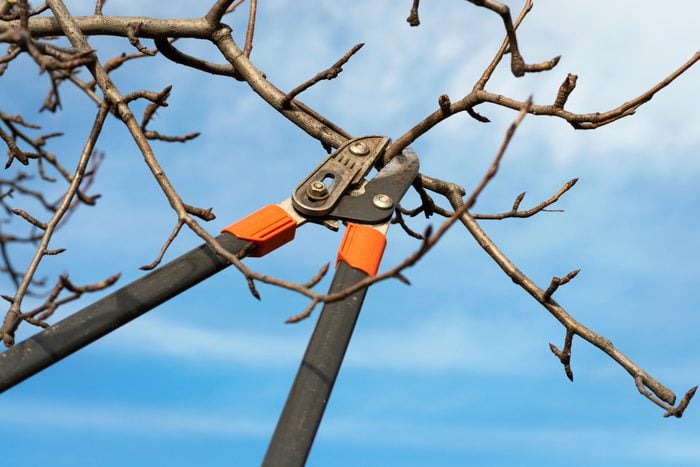Can I Trim Bare Trees in the Winter?
Updated: Apr. 18, 2023

Many people are surprised to learn winter is a good time to prune bare trees — weather permitting, of course.
I pruned my own trees as long as I could until I realized that, even on a ladder, I couldn’t quite reach the one branch I really wanted to cut off. Following the age-old wisdom of better safe than sorry, I hired an arborist the next time my trees needed to be pruned. At his suggestion, we waited until winter to do most of it.
On This Page
Why Trim Bare Trees in Winter?
There are several reasons why you should trim bare trees in winter.
Lessen the chance of disease
Winter pruning reduces the likelihood of the tree becoming infected with a disease like oak wilt.
“Winter pruning is preferred primarily because airborne pathogens, bacteria and fungi are far less active during the cold months,” says Lou Meyer of the Davey Tree Expert Company.
“When we open the tree’s internal parts, we open a direct entry for those issues. This is similar to when humans have surgery. Post-operative care is vital for infection control. Winter pruning allows us to get a jump on that.”
Easier to see the tree’s structure
Meyer also notes you can more easily see branches crossing each other and other structural issues when there are no leaves on the tree. With proper pruning, these issues can be corrected, especially if it’s a young tree.
Even in the winter, a good arborist trained in tree care can tell if a branch is dead or alive and can remove the dead ones.
Less damage to the rest of the garden
When the ground is frozen, it may be easier to reach some trees without ruining the rest of the yard or garden. If your trees are big enough, an arborist may bring in a bucket truck to reach the top branches.
Can You Still Prune Trees in Summer?
Yes. However, according to Meyer, “You should reserve non-winter pruning for immediate needs.” These might include:
- Removing clearly dead branches;
- Removing branches blocking traffic signs or pathways;
- Removing branches interfering with nearby buildings;
- Cleaning up branches that broke off in a storm.
What You Shouldn’t Prune in Winter
Avoid pruning spring-flowering shrubs in the winter. Often these shrubs form their flower buds in the fall, so pruning or shearing them back in the winter means no flowers in the spring. This is especially true for lilacs, forsythias and smaller magnolias.
Should You Hire a Certified Arborist?
That depends. If you own the proper equipment and have smaller trees, or trees with just a few broken or dead lower branches, you can easily do your own tree pruning. Proper equipment may include a pruning saw, eye protection and heavy-duty gloves.
If you have larger trees or see signs of disease, consider hiring a certified arborist. They’ll bring training, experience and the proper equipment to ensure your tree is pruned correctly at the right time of year.
When hiring someone to prune your trees, check references and make sure they’re properly licensed and insured. Ask them how they plan to prune your trees, and verify they’ll remove all the branches so you’re not left with a mess to clean up.
If your arborist brings a wood chipper, ask if they can leave a pile of chips you can use as mulch in some areas of the garden. Skip this step if the tree is diseased.
